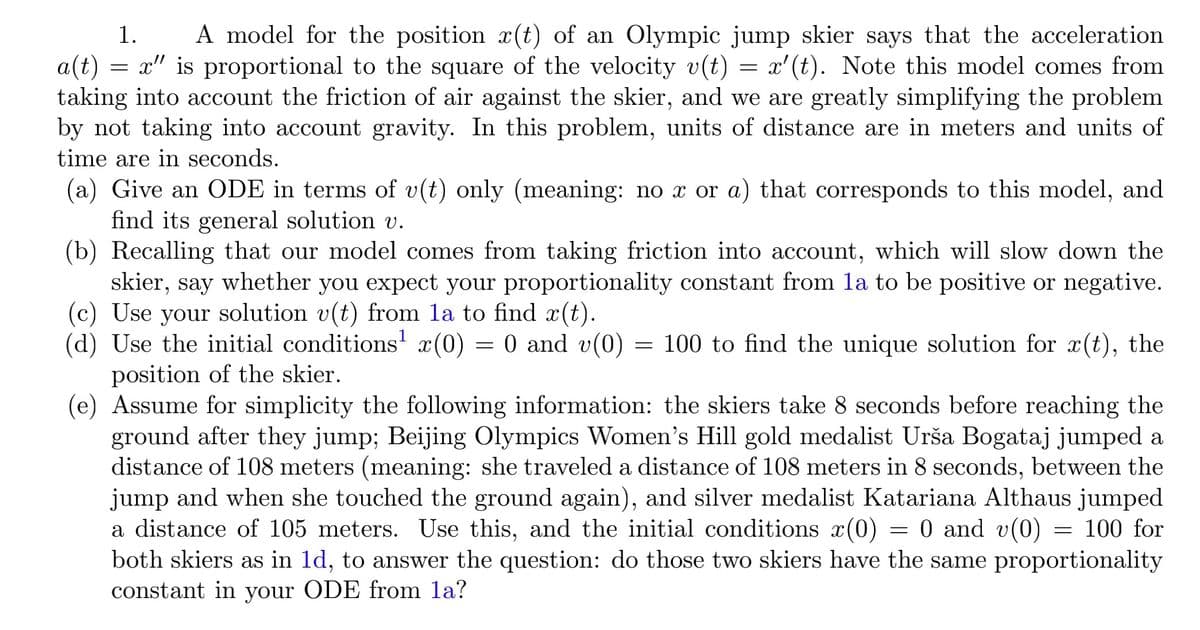1. A model for the position x (t) of an Olympic jump skier says that the acceleration a(t) = x" is proportional to the square of the velocity v(t) = x'(t). Note this model comes from taking into account the friction of air against the skier, and we are greatly simplifying the problem by not taking into account gravity. In this problem, units of distance are in meters and units of time are in seconds. (a) Give an ODE in terms of v(t) only (meaning: no x or a) that corresponds to this model, and find its general solution v. (b) Recalling that our model comes from taking friction into account, which will slow down the skier, say whether you expect your proportionality constant from la to be positive or negative. (c) Use your solution v(t) from la to find x(t). (d) Use the initial conditions x(0) position of the skier. = 0 and v(0) = 100 to find the unique solution for x(t), the
1. A model for the position x (t) of an Olympic jump skier says that the acceleration a(t) = x" is proportional to the square of the velocity v(t) = x'(t). Note this model comes from taking into account the friction of air against the skier, and we are greatly simplifying the problem by not taking into account gravity. In this problem, units of distance are in meters and units of time are in seconds. (a) Give an ODE in terms of v(t) only (meaning: no x or a) that corresponds to this model, and find its general solution v. (b) Recalling that our model comes from taking friction into account, which will slow down the skier, say whether you expect your proportionality constant from la to be positive or negative. (c) Use your solution v(t) from la to find x(t). (d) Use the initial conditions x(0) position of the skier. = 0 and v(0) = 100 to find the unique solution for x(t), the
Chapter3: Polynomial Functions
Section3.5: Mathematical Modeling And Variation
Problem 7ECP: The kinetic energy E of an object varies jointly with the object’s mass m and the square of the...
Related questions
Question

Transcribed Image Text:A model for the position x(t) of an Olympic jump skier says that the acceleration
a(t) = x" is proportional to the square of the velocity v(t) = x'(t). Note this model comes from
taking into account the friction of air against the skier, and we are greatly simplifying the problem
by not taking into account gravity. In this problem, units of distance are in meters and units of
1.
time are in seconds.
(a) Give an ODE in terms of v(t) only (meaning: no x or a) that corresponds to this model, and
find its general solution v.
(b) Recalling that our model comes from taking friction into account, which will slow down the
skier, say whether you expect your proportionality constant from la to be positive or negative.
(c) Use your solution v(t) from la to find x(t).
(d) Use the initial conditions' x(0) = 0 and v(0)
= 100 to find the unique solution for x(t), the
position of the skier.
(e) Assume for simplicity the following information: the skiers take 8 seconds before reaching the
ground after they jump; Beijing Olympics Women's Hill gold medalist Urša Bogataj jumped a
distance of 108 meters (meaning: she traveled a distance of 108 meters in 8 seconds, between the
jump and when she touched the ground again), and silver medalist Katariana Althaus jumped
a distance of 105 meters. Use this, and the initial conditions x(0)
both skiers as in 1d, to answer the question: do those two skiers have the same proportionality
constant in your ODE from la?
= 0 and v(0) = 100 for
Expert Solution
This question has been solved!
Explore an expertly crafted, step-by-step solution for a thorough understanding of key concepts.
Step by step
Solved in 5 steps with 5 images

Recommended textbooks for you


Trigonometry (MindTap Course List)
Trigonometry
ISBN:
9781337278461
Author:
Ron Larson
Publisher:
Cengage Learning


Trigonometry (MindTap Course List)
Trigonometry
ISBN:
9781337278461
Author:
Ron Larson
Publisher:
Cengage Learning